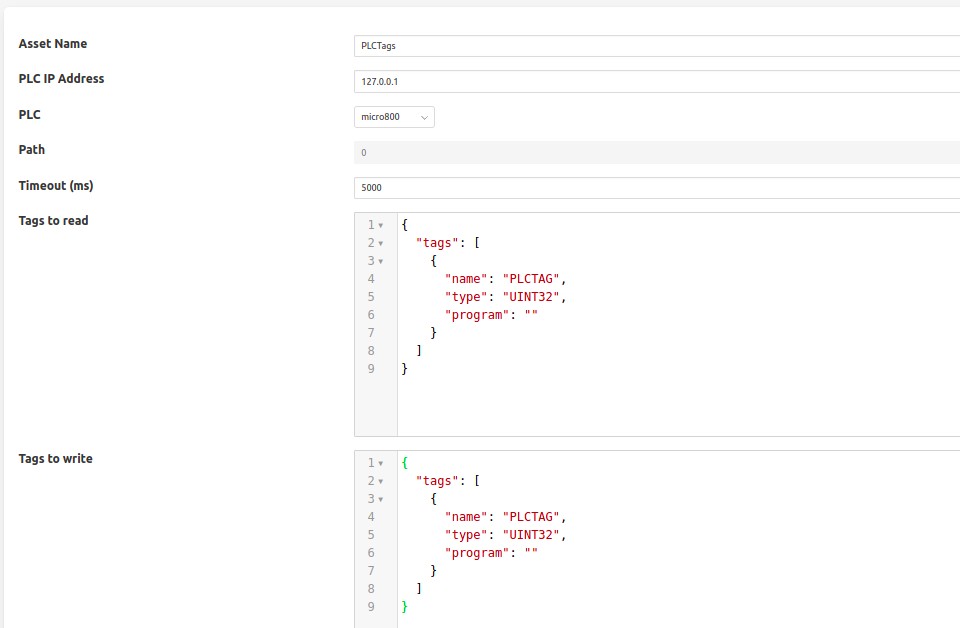EtherIP South Plugin¶
The foglamp-south-etherip plugin is a south plugin that supports PLC Tags read operation for Allen Bradley/Rockwell PLCs. This is based on libplctag and API level details can be read at wiki
Configuration Parameters¶
An EtherIP south service is added in the same way as any other south service in FogLAMP,
Select the South menu item
Click on the + icon in the top right
You will be presented with the following page
|
Select etherip from the plugin list
Enter a name for your etherip service
Click Next
You will be presented with the following configuration page
|
Asset Name: This is the name of the asset that will be used for the data read by this service. Default Value PLCTags
PLC IP Address: This is the IP Address of the PLC Tags server, Default value 127.0.0.1
PLC: This is the type of the PLC from which the user wants to read the tags, Default value controllogix, the following have been supported:
Allen-Bradley ControlLogix & CompactLogix PLCs
Allen-Bradley Micro8x0 PLCs
Rockwell/Allen-Bradley PLCs accessed over a DH+ bridge (i.e. a LGX chassis with a DHRIO module) such as PLC/5, SLC 500 and MicroLogix
Omron NX/NJ series PLCs as for Allen-Bradley Micro8x0
Path: This is the slot/rack(e.g. 0,1) to use to connect to your PLCTags device. This attribute is required for CompactLogix/ControlLogix tags and for tags using a DH+ protocol bridge (i.e. a DHRIO module) to get to a PLC/5, SLC 500, or MicroLogix PLC on a remote DH+ link. The attribute is ignored if it is not a DH+ bridge route, but will generate a warning if debugging is active. Note that Micro8x0 connections must not have a path attribute.
Timeout (ms): The request timeout when communicating with a PLCTags server. Default value is 5000 (milliseconds).
Tags to read: The map defines which PLCTags user wants to read. The map is a complex JSON object which is described in more detail below.
Tags to write: The map defines which PLCTags user wants to write to. The map is a complex JSON object which is described in more detail below.
Map¶
The map of tags to read/write is a JSON object with a single array tags, each element of this array is a JSON object that defines a single item of data that will be stored in FogLAMP or written as set-point control. These objects support a number of properties and values, these are
Property |
Description |
|---|---|
name |
The name of the PLCTag that we are reading/writing. In case of read, this becomes the name of the datapoint with the asset. |
type |
The datatype of the PLCTag that we are reading/writing. |
program |
This defines the scope of the PLCTag that we are reading/writing, possible values being Program level scope or Global/Controller level scope. The Program name needs to be specified here if it is a tag with program level scope. For global/controller level tags ‘program’ attribute in map can be omitted or set to JSON null value or empty. |
Example JSON Map¶
In this example we will assume we have a Micro8x0 PLC and we want to read one tag with name Tag1, type UINT32 and having global/controller level scope. Also we want to write to a tag with name Tag2, type UDINT and having global/controller level scope.
The Tags to read Map attribute for this example would be as follow:
{
"tags": [
{
"name": "Tag1",
"type": "UINT32",
"program": ""
}
]
}
The Tags to write Map attribute for this example would be as follow:
{
"tags": [
{
"name": "Tag2",
"type": "UDINT",
"program": ""
}
]
}

